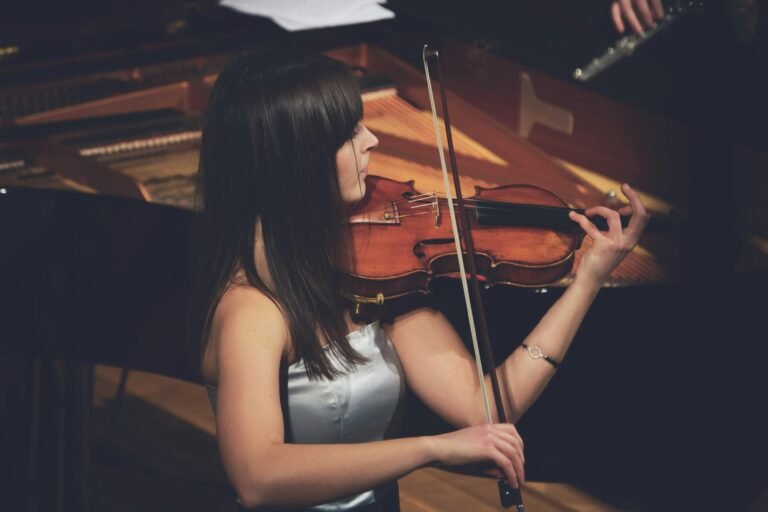Introduction to Modern Violin Learning Techniques
Over the years, violin teaching techniques have undergone significant transformations. Historically, violin instruction was predominantly based on traditional methods, where students learned exclusively through in-person lessons and rigorous practice routines. However, the advent of modern technology has revolutionized how the violin is taught and learned.
One of the most notable changes in violin learning methods is the integration of digital resources. Educational platforms such as online video tutorials, interactive apps, and virtual masterclasses have made the instrument more accessible to a global audience. These resources offer a range of learning tools that cater to various skill levels, from beginner to advanced, thus democratizing access to professional-grade instruction.
Another significant shift lies in the personalized learning experiences these innovative methods offer. Adaptive learning technologies employ algorithms to personalize practice sessions based on the learner’s progress, effectively allowing for customized feedback and targeted improvement. This approach has proven to accelerate learning outcomes, as students can focus on their unique weaknesses while reinforcing their strengths in real time.
The social aspect of learning the violin has also evolved. Online communities and social media platforms provide spaces for violinists to share their progress, participate in challenges, and receive encouragement from peers and instructors worldwide. This global network fosters a sense of camaraderie and motivates learners to achieve their musical goals.
Additionally, staying updated with the latest trends and techniques is crucial to maximizing learning outcomes. New methodologies and technological advancements continue to emerge, making it essential for both learners and educators to remain informed about evolving educational landscapes. The amalgamation of traditional and modern violin teaching techniques creates a robust and flexible learning framework that caters to the diverse needs of contemporary students.

Optimal Age for Starting Violin Lessons
The question of the optimal age to begin violin lessons is complex and multi-faceted, shaped by both current research and expert opinions. While it is often believed that starting musical education early in childhood offers significant benefits, this is not a one-size-fits-all rule. Let us delve into the advantages and disadvantages of starting violin lessons at different life stages: early childhood, adolescence, and adulthood.
Research suggests that early childhood, particularly between ages five to seven, is an advantageous time to start learning the violin. During this period, children are highly receptive to new skills, and their developing brains can absorb musical concepts more efficiently. Early starters often experience improved cognitive abilities, better academic performance, and enhanced fine motor skills. However, this stage also comes with challenges such as the need for parental involvement, the potential for short attention spans, and the requirement of a patient and flexible teaching approach.
Adolescence presents another crucial window for beginning violin lessons. Teenagers usually possess greater physical strength and better hand coordination, making it easier to handle the instrument. Additionally, self-discipline and advanced cognitive skills can facilitate quicker learning. Nonetheless, the adolescent years can be accompanied by emotional fluctuations and busy academic schedules, which might interfere with consistent practice and progress.
Starting violin lessons in adulthood, while less common, is increasingly gaining acceptance. Adults bring analytical thinking, emotional depth, and determination to the learning process. These qualities can enhance the appreciation and understanding of violin music on a deeper level. Nevertheless, adults may face hurdles such as reduced neuroplasticity compared to children, potential physical limitations, and constraints on available practice time due to professional and personal responsibilities.
For parents considering when to introduce their children to the violin, it is essential to assess the child’s interest, attention span, and ability to handle the instrument. Consulting with a music instructor can provide personalized insights. Adults considering violin lessons should focus on setting realistic goals and consistent practice routines to facilitate gradual but steady progress.
Choosing the Right Violin Teacher: Face-to-Face vs. Online vs. Offline Lessons
When embarking on the journey to learn the violin, selecting the right violin teacher is crucial. Your choice can significantly affect your progression and enthusiasm for the instrument. The first decision to make is the format of the lessons: face-to-face, online, or offline. Each option has distinct advantages and challenges, and your decision should align with your personal learning preferences and goals.
Face-to-face lessons are the traditional method of learning an instrument. These offer the benefit of immediate, in-person feedback. The teacher can physically demonstrate techniques, correct posture, and provide hands-on adjustments. This format is particularly advantageous for beginners who need more direct guidance. However, face-to-face lessons can be less flexible, requiring you to travel to a specific location and adhere to a fixed schedule. This might not be ideal for those with busy lives or those who live in areas with limited access to qualified violin teachers.
In contrast, online violin lessons have grown in popularity, especially due to recent advancements in technology. With video conferencing tools, students can now connect with teachers worldwide. This widens the pool of potential instructors significantly. Online lessons offer exceptional flexibility regarding scheduling and location, making it easier to fit lessons into a busy lifestyle. They also often come at a lower cost compared to face-to-face lessons. However, the lack of physical presence can pose challenges. Issues such as latency, sound quality, and the inability to make physical adjustments could potentially hinder the learning experience for some students.
Offline learning represents a self-directed or autodidactic approach, often supplemented by resources like instructional books, videos, and self-practice. This method provides the highest level of flexibility and customization, allowing learners to progress at their own pace. It can be an appealing option for those with strong self-discipline and prior musical experience. However, without regular feedback and accountability, it can be difficult to correct mistakes and ensure consistent progress.
When evaluating a potential violin teacher, regardless of the format, consider their credentials and teaching style. Check their qualifications, such as degrees in music or certifications from recognized institutions. Additionally, read reviews or seek recommendations from other students. Observe if the teacher’s style and methods resonate with your learning preferences and goals. Ideally, a good teacher should be adaptable, able to customize lessons based on your individual progress and needs, and capable of providing constructive feedback in your preferred learning environment.
Setting Up an Effective Practice Routine
A productive and sustainable practice routine is essential for mastering the violin. Time management is the cornerstone of an effective routine. Begin by allocating specific time slots dedicated solely to practice. Consistency plays a crucial role; aim for daily sessions even if they are short, as regular practice reinforces muscle memory and aids in the retention of techniques.
Breaking down practice sessions into manageable segments can significantly enhance productivity. Start with warm-up exercises to prepare the muscles and prevent injury. Follow up with technical drills such as scales, arpeggios, and etudes. This portion should focus on refining technique and building a solid foundation. The next segment can be dedicated to repertoire practice, allowing you to apply the techniques you’ve honed. Conclude with a cool-down period to relax and evaluate your progress.
Setting achievable goals is key to maintaining motivation. Short-term goals, such as mastering a specific passage or improving intonation, provide immediate milestones to work toward, while long-term goals like preparing for a performance or an exam offer broader objectives. Document these goals and review them regularly to stay on track.
Incorporating modern tools and apps can streamline your practice sessions and track progress effectively. Metronome apps, for example, help in maintaining accurate tempo, and tuner apps ensure you’re playing in tune. Platforms like SmartMusic and MusicPractice can structure your sessions, offering feedback and tracking your advancement over time. Additionally, recording practices and listening back can be invaluable for self-assessment.
In summary, an effective practice routine combines consistent time management, segmented and focused practice sessions, and the use of modern tools to create a structured and rewarding learning experience. By setting clear, achievable goals and utilizing available resources, you’ll establish a productive path towards mastering the violin.
Incorporating Technology into Violin Practice
In the contemporary landscape of music education, technology plays a pivotal role in augmenting traditional learning methods. Utilizing modern technology to enhance violin practice can yield significant improvements in skill acquisition and practice efficiency. One notable category of technological aids includes mobile applications and online platforms specifically designed for music learners. These tools offer a range of functionalities, from interactive lessons to real-time feedback, making them indispensable for today’s violin students.
Apps such as Yousician and Trala provide structured learning paths that cater to different proficiency levels, offering personalized lesson plans and performance assessments. These platforms use the device’s microphone to listen to your playing and offer instant feedback on pitch accuracy, rhythm, and technique. This immediate corrective guidance can foster more effective practice sessions and accelerated learning.
Digital tuners and metronomes are also essential components of a modern violinist’s toolkit. Apps like Tunable and Pro Metronome not only help maintain pitch and tempo but also come with features like drone notes for pitch training and complex rhythm patterns to challenge and improve timing accuracy. Utilizing these apps can ensure a violinist remains in tune and rhythmically sound, both critical elements in mastering the instrument.
Moreover, platforms such as YouTube and MasterClass provide access to expert violinists and educators. Watching instructional videos and tutorials offers a visual and auditory learning experience, breaking down complex techniques and pieces into manageable segments. Observing experienced musicians can also serve as a source of inspiration and motivation.
For those looking to deepen their understanding of music theory and sight-reading, apps like Music Theory Pro and Simply Piano offer comprehensive courses and exercises. These resources can enhance one’s ability to read music and understand the theoretical underpinnings of the pieces being played, making the learning process more holistic and integrated.
In conclusion, the integration of technology in violin practice opens up a realm of possibilities for learners. By utilizing apps, online platforms, digital tuners, and metronomes, violinists can streamline their practice routines, receive focused feedback, and gain access to a wealth of instructional content. These tools collectively contribute to a more efficient and enriching learning experience, ensuring that modern violinists are well-equipped to hone their craft effectively.
Evaluating Progress and Checking Homework
Evaluating progress in learning the violin is crucial to ensure that students are meeting their learning objectives and advancing effectively. One of the key strategies for this is the implementation of regular self-assessment. Students should keep a practice journal where they record what they worked on during practice sessions, challenges faced, and areas where they noticed improvement. This practice not only helps in tracking progress but also in setting daily and weekly goals.
Peer review is another useful method for checking homework and progress. Engaging with fellow students can provide a fresh perspective and constructive criticism. It encourages a collaborative learning environment where students can learn from each other’s strengths and weaknesses. Organizing occasional group practice sessions or informal recitals can offer students the opportunity to perform in front of peers and receive feedback.
Teacher feedback remains an essential element of effective evaluation. Regular lessons provide structured feedback, helping students identify areas that need more practice and refinement. Teachers can assess posture, technique, and intonation more accurately in person, offering personalized guidance. Incorporating checkpoints during lessons where teachers review specific assignments or pieces ensures that students remain on track.
Setting benchmarks is instrumental in providing measurable goals. These benchmarks might include mastering a particular piece, achieving a certain speed or accuracy in scales, or other specific technical skills. Having these clear milestones helps students recognize their achievements and stay motivated over the long-term process of learning the violin.
Using recordings to track improvements over time is also highly beneficial. Students should regularly record their practice sessions and performances. Listening to these recordings allows for objective self-evaluation and helps in identifying subtle improvements or persistent mistakes that might not be noticeable during live practice. Software and apps that provide visual feedback, such as pitch and rhythm accuracy, can further enhance this process by offering detailed insights.
Effectively evaluating progress and checking homework requires a blend of self-assessment, peer interaction, and professional guidance. By setting clear benchmarks and leveraging recordings, students can maintain a structured and reflective approach to mastering the violin, ensuring consistent and measurable improvement over time.
Overcoming Common Challenges and Maintaining Motivation
Learning the violin can be a rewarding yet challenging endeavor. Many beginners encounter common obstacles such as frustration, plateaus, and time constraints. Recognizing these challenges early can aid in developing effective strategies to overcome them.
Frustration often arises from slow progress or difficulties in grasping complex techniques. One practical solution is to break down difficult pieces into smaller, manageable sections. Focusing on incremental progress rather than immediate perfection can alleviate feelings of frustration. Additionally, engaging in regular practice sessions, even if only for short durations, can foster steady improvement and boost confidence.
Plateaus are another frequent challenge. A plateau can be demotivating, causing learners to feel stuck despite their efforts. Overcoming plateaus requires varied practice routines. Incorporating different styles of music or new techniques can inject freshness into practice sessions, reigniting interest and pushing past stagnation. Seeking feedback from a violin teacher or joining a violin community can also provide new insights and motivators.
Time constraints are a common hurdle for many aspiring violinists. Balancing practice with other commitments demands effective time management. Prioritizing practice within a daily schedule and setting realistic goals can ensure consistent progress without overwhelming the learner. Utilizing practice aids, such as metronomes or instructional videos, can help maximize the efficiency of limited practice time.
Maintaining motivation is crucial for long-term success. Developing a growth mindset, which embraces effort and learning from mistakes, is fundamental. Celebrating small achievements and progress milestones can provide positive reinforcement. Additionally, reflecting on the initial reasons for learning the violin can serve as a powerful reminder of the joy and satisfaction that comes with musical advancement.
In conclusion, by addressing common challenges proactively and fostering a supportive learning environment, violin learners can overcome obstacles and remain motivated on their journey toward mastery. Practicing patience, embracing a growth mindset, and seeking positive reinforcement will drive continued improvement and enjoyment in playing the violin.
Building a Community and Finding Support
Learning the violin can often feel like an isolating pursuit, but building a supportive community is essential for sustaining motivation and progressing effectively. Connecting with fellow learners, teachers, and mentors provides a network of support that can significantly enhance your violin learning journey. This interconnectedness not only fosters a sense of belonging but also opens up avenues for shared experiences, advice, and encouragement.
Social media platforms are invaluable tools for creating such communities. Numerous online groups and forums dedicated to violin enthusiasts are available on platforms like Facebook, Reddit, and specialized music forums. Joining these groups allows you to engage in discussions, ask questions, and share milestones with like-minded individuals from around the world. The diverse perspectives and collective knowledge found in these virtual communities can offer fresh insights and solutions to common challenges faced by violin learners.
Local music groups and orchestras are also excellent for building a physical community. Participating in local ensemble activities not only helps improve your skillset through practice and performance but also introduces you to peers and potential mentors. In many regions, community music schools and local arts organizations host events where musicians can collaborate, learn from each other, and build durable, supportive relationships.
For those who prefer structured guidance, online mentorship programs provide a valuable resource. Many established violinists offer mentorship through digital courses, webinars, and personalized coaching sessions. These programs often forge strong mentor-student relationships, providing tailored advice and motivation to help you push through challenging phases of learning.
Having a robust support system of individuals who share your passion for the violin – whether online or in-person – is crucial. Such a network not only maintains your enthusiasm but also provides practical benefits by allowing you to learn from others’ experiences and stay informed about various learning methodologies and opportunities. Ultimately, these connections form a foundation that supports continuous growth and enjoyment in your violin journey.



